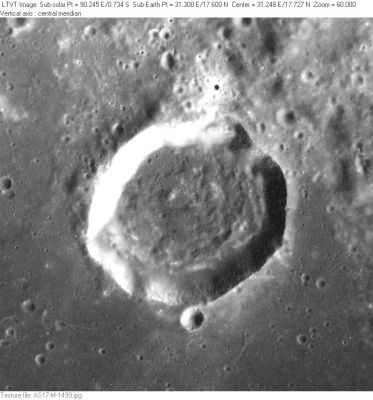Vitruvius
Contents
Vitruvius
|
Lat: 17.6°N, Long: 31.3°E, Diam: 29 km, Depth: 1.88 km, Rükl: 25, Upper Imbrian |
Images
LPOD Photo Gallery Lunar Orbiter Images Apollo Images (see also: Vitruvius, east of)
- Vitruvius was also photographed during the historic first manned mission to the moon in december 1968 (Apollo 8).
See AS08-13-2347 and AS08-13-2350.
On both photographs, the camera was looking northward at the mountainous region around Apollo 17's Taurus-Littrow landing site (december 1972).
Vitruvius itself is the pronounced crater with the shadowed interior and the small craterlet on its southern rim. The wrinkle-ridged region in the foreground is part of Mare Tranquillitatis.
- A shadowless Vitruvius was captured near the right margin of the oblong panoramic ITEK-camera frame AS15-P-9862.
- Research orbital Apollo photographs: Danny Caes
Maps
(LAC zone 43D4) LAC map Geologic map LTO map
Description
Description: Elger
(IAU Directions) VITRUVIUS.--A ring-plain 19 miles in diameter with bright but not very lofty walls, situated among the mountains near the S.E. side of the Mare Serenitatis. It is surrounded by a region remarkable for its great variability in brightness. There is a large bright ring-plain on the E., with a less conspicuous companion on the S. of it.
Description: Wikipedia
Additional Information
- Depth data from Kurt Fisher database
Pike, 1976: 1.88 km
Arthur, 1974: 1.55 km
Westfall, 2000: 1.88 km
Viscardy, 1985: 1.55 km
Cherrington, 1969: 2.31 km - Vitruvius A is a thermal anomaly crater, implying youthful age - Moore et al, 1980
Nomenclature
- Vitruvius Pollio, Marcus; Roman engineer, architect (unkn-fl. c. 25 B.C.).
- Crater Vitruvius B was called Fisher by Wilkins and Moore, but the I.A.U. did not accept that name. Fisher was an American astronomer (1878-1949).
- Crater Vitruvius G was unofficially called El Greco on Lunar Topographic Ortophotomap 61-A1. Who was El Greco? See this Wikipedia-page.
LPOD Articles
Bibliography
